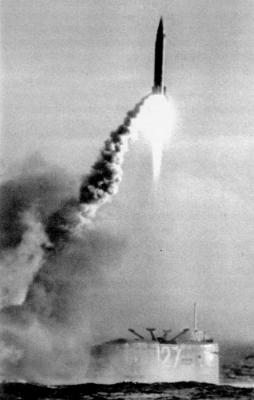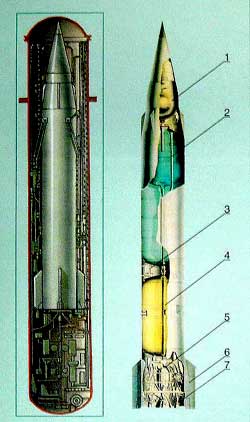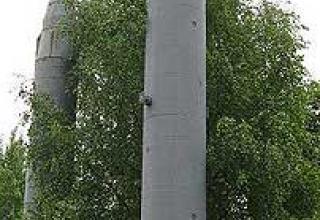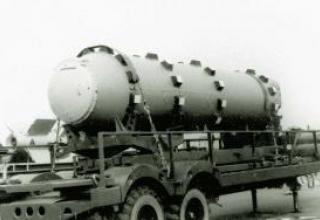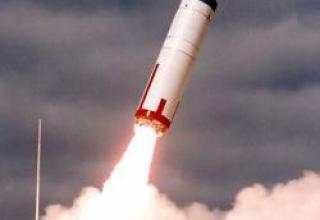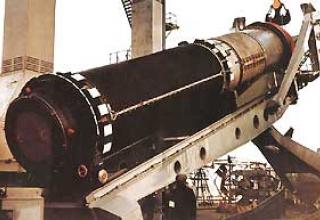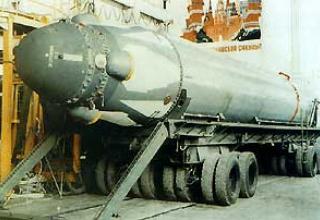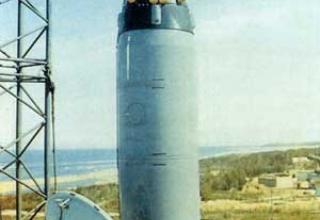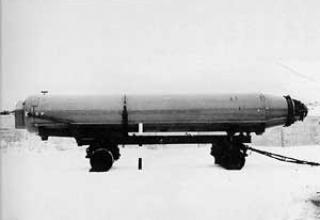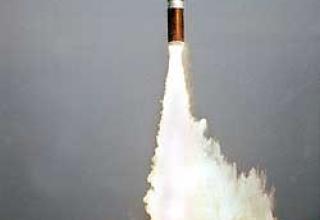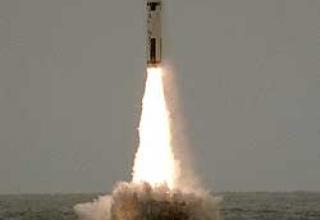The Decree of the USSR CM of July 25, 1955 provided for the development of an ocean submarine of project 629, armed with a missile system D-2 with a missile R-13, designed taking into account the peculiarities of operation on the submarine, as well as having improved tactical and technical characteristics. As a matter of fact, this Resolution set the task of creating the first combat missile system with ballistic missiles designed specifically for arming Submarine 629 and the first nuclear submarine of project 658. The tactical and technical task for the development of the D-2 complex was approved on January 11, 1956.
The D-2 missile system with the R-13 ballistic missile for submarines was designed to deliver powerful nuclear strikes against military, strategic, administrative, political and economic centers of the enemy and at that time was of strategic importance.
Work on the conceptual design was started at Design Bureau-1 under the leadership of S.P.Korolev, and then transferred to the Miass Machine Building Design Bureau (chief designer - V.P.Makeev). The SM-60 starter unit for the D-2 complex was developed at the Central Design Bureau-34 (KBSM) under the supervision of E.G.Rudyak, Chief Designer of Design Bureau-1; the control devices were developed by NII-49. During the development of SM-60, in accordance with the proposal of S.P.Korolev, the possibility of using the R-11FM missiles was provided. Perhaps, this proposal of S.P.Korolev was due to the fact that in the event of a delay in the development of the R-13 missile, the first PL of Pr 629 could be delivered with R-11FM missiles. Despite the fact that this required KB-1 to develop a separate launch device for R-11FM, this proposal was accepted. KB-1 developed a set of devices (the launch table, the launch device, the emergency release mechanism units) for R-11FM. The Design Bureau-1 of the Research Institute-88 also made some changes to the R-11FM missile (copiers for unlocking the locks, etc.), providing unlocking the locks of the launch device and scattering the racks with the missile.
During the factory tests of SM-60, as well as during the unfolded serial production in 1957-58 and installation of the first units on the PL Pr.629, the configuration was carried out with two launchers: for missiles R-13 and R-11 FM. Flight design tests of R-13 missile in Kapustin Yar were carried out at the stand SM-49, after it was equipped with launching devices and other nodes necessary to ensure the launch of these missiles. By the end of installation of the first PL Prospect 629 LKI of R-13 missile were completed and all PLs were equipped with only R-13 missile launchers.
In 1960, the D-2 missile system was adopted for service on the DEPL project 629 (chief designer N.N. Isanin), and then - a submarine of project 658 (chief designer S.N. Kovalev). Series production of missiles was launched at Zlatoust Machine Building Plant in 1959.
R-13 missile (as well as its predecessor R-11FM missile of D-1 complex) could be launched only from above-water position, which significantly reduced the combat efficiency of new submarines. And even the large unification of the design with R-5M, which made production cheaper, in this case did not play a noticeable positive role. The Soviet R-13 missile was inferior to the American Polaris A-1 SLBM, which was built somewhat earlier, in all major respects. Therefore, the next logical and necessary step was to master the submarine launch. This problem was solved in the development of the D-4 complex with R-21 missile, which began in 1959.
R-13 missiles were in service with diesel submarines of 629A project and nuclear submarines of 658 project until 1973. In 1963-1967, seven of the eight built Project 658 submarines with D-2 missile systems were converted to Project 658M submarines with D-4 missile systems. In 1969, the conversion of the latter, the eighth submarine of Prospect 658, with the D-2 missile system, into a 701 project submarine for testing R-29 missiles began. By 1979, all Prospect 629 Submarines with D-2 missile systems were decommissioned from the fleet.
At the end of 1959, KB-1 prepared technical documentation for the SM-60 missile system for its transfer to the People's Republic of China.
Composition:
The D-2 complex consisted of three mine type launchers, shipborne missile firing control devices and special systems. The ship's navigation systems provided for the preparation of missile firing, giving the missile system data on the place, speed and course, the angles of rocking the submarine. The mine with special systems belonged to the ship's devices (ventilation, system of mine flooding and drainage, the lid of the mine).
R-13 - single-stage surface launch rocket with liquid propellant on stored high boiling fuel. Fuel tanks were made bearing and formed a fuel compartment. Fuel components are self-combustible, oxidizer is a solution of nitrogen four-oxide in concentrated nitric acid, fuel TG-2 is a mixture of xylidine and triethylamine. To increase safety, the oxidizer tank was refueled in the base before the submarine went into military service, and the fuel tank - in the sea from the boat tanks directly during the pre-start preparation. The fuel tanks were placed outside the strong hull of the submarine - in the fence of the deckhouse. The missiles could stay in the mines in the fueled state for up to three months. At the end of this period they had to be unloaded to check their technical condition. The missile complex was served by 10 people.
The rocket propulsion system included a five-chamber liquid propellant rocket engine with a thrust of 25.7 tons. It had a central combustion chamber and four steering chambers, and was designed to be open. The marching engine was developed at the Chemical Engineering Design Bureau under the leadership of Alexey Isaev. The ground equipment complex was developed at the Moscow Transport Engineering Design Bureau under the leadership of Vladimir Petrov.
The control system - inertial - was developed at the Sverdlovsk Design Bureau-626 (NPO automatics) under the supervision of Chief Designer Nikolay Semikhatov and was intended for testing of initial disturbances at launch from a submarine and for launching the missile on a given flight path, for stabilization and program control of the missile, for determination of the head end separation moment. It provided accuracy of firing (CWO) of 4 km.
R-13 carried a detachable monoblock head unit with a thermonuclear charge with a power of 1 Mt, which allowed to strike targets on the ground. The head unit was equipped with stabilisers.
The design of the missile and the launcher allowed the launch of the missile from the upper section of the mine in the surface position of the boat at a speed of up to 15 knots, on any course angle and when the sea waves up to five points. The first missile could be launched 4 minutes after the ascent, not 15 minutes after the R-11FM.
The mechanisms and devices that determined the general scheme and layout of the SM-60 starter unit (see diagram) had original technical solutions. Such devices were among them:
- chain hoist with push-type chains and electro-hydraulic table lift drive;
- starting device with automatic scattering mechanism and information of the posts of this device;
- a system of cushioning and fastening of the missile in a walking mode;
- a device for emergency discharge of a defective missile overboard.
To improve the operating conditions of the complex on the PL, a fixed missile installation on the launch table pins was used, which excludes vertical and azimuth alignment of the missile after its loading on the launch table. The table lift mechanism is made with two pusher chains with guides for chains inside the mine. The table lifting was performed to rigid stops. When approaching the rigid stops, the hydraulic brakes of the lifting drive were automatically engaged, the table was pressed against the stops and reliably held during the rocking and launching of the rocket. The lift table was a welded and cast construction of two thin-walled castings. The table had a rotary table with a drive to point the missile at the azimuth. On the rotary table there was a launch table, a launching device, a mechanism of scattering and information of racks and a device for emergency dropping of the rocket overboard. The weight of the lift-and-turn table with the devices, placed on it and R-13 missile, was 33 t. The lifting height of the table was 12m. The capacity of the electric motor of the lift drive was 110KW.
The corset-type launcher had four props with grips forming an upper belt holding the missile until launch. The four-pillar layout of the launcher ensured that it was equally stiff on the rocker at any azimuth position of the rotary table and that the missile had a reliable mismatch with the upper grips during launch. During the rocket launch and its lifting by 120 mm with the help of copiers located on its body, there was a forced opening of the launch device locks and automatic spread of the racks at an angle of 60 ° under the influence of a powerful spring mechanism. To brake the props, at the end of their folding, hydraulic brakes were provided in the mechanism of scattering of props. After starting, the props were automatically folded down by two hydraulic cylinders when the table was lowered into the shaft using the lift chain guides as copiers.
The verticality of the rocket was ensured by the aligned horizontal plane of the launch table. The starting position in azimuth was provided by the locking pins of the launch table. Emergency dump of the rocket was provided for PL Pr.629 in conditions of constant roll up to 8° and amplitude of lateral rocking up to 5°. In this case the rotary table was set in the "reset" position, at which the missile was dropped on the starboard side. To reset the rocket on the launch table had a frame, and in the rotary table were two pneumatic cylinders, which unfolded the frame, resulting in the rocket, due to the moment of its own weight, fell overboard.
Launch unit SM-60 as part of the D-2 complex was in service with the Navy for 12 years. During this time there were no failures in the launch of the R-13 missile due to malfunctioning mechanisms and devices of the SM-60 installation. During the operation of the complex any comments on the design of SM-60 installation of its reliability and safety from the fleets and management of the Navy did not come.
Characteristics:
| Maximum firing range, km | 600 | |
| Start mass, t | 13.74 | |
| The length of the rocket, m | 11,8 | |
| Maximum housing diameter, m | 1.3 | |
| Number of steps | 1 | |
| Weight of payload, t | 1.597 | |
| Monoblock HF nuclear warhead power, Mt. | 1 | |
| KVO, km | 4 | |
| Missiles on standby, months | 3-6 | |
| Storage life of the missile, years | 5-7 | |
Testing:
To test the D-2 complex for explosion resistance, the Central Design Bureau-16 developed a pilot compartment of the RO-629 PL with two shafts and the SM-60 launchers, R-13 missiles and D-2 complex systems located in them. During these tests in 1960, the RO-629 compartment was loaded with non-contact explosions of depth charges, mines and rope charges simulating the impact of an underwater nuclear explosion. The tests were successful and there were no comments on the need for any modifications to the SM-60 and PL facilities.
At the surrender testing of the PL Pr.629, one of the PL had two failures in the launch of missiles R-13. As later established by the Commission, the reason for this were malfunctions in the manufacture of missiles. The commander of the PL was reset one malfunctioning rocket overboard devices emergency dropping the PP, and thus, these devices have been tested in real conditions. If the commander of the PL refused to launch the second missile, it was decided to lower the missile with a lifting table in the mine and then flood the mine. Carried out then defect rocket R-13 at the manufacturing plant allowed to establish the cause of failure of the rocket at its launch.
On October 20, 1961 R-13 missile was launched with the subsequent nuclear explosion at the Novaya Zemlya test site. This is the first and only test launch of submarine ballistic missile with a nuclear explosion in the history of the country.
The D-2 missile system proved more reliable than its predecessor, the D-1. As a result of tests conducted in various, including tropical, conditions, it was possible to significantly increase the period of continuous storage of R-13 missiles on a submarine in a state of readiness. During the whole period of operation, 311 launches of R-13 missiles were conducted, of which 225 were considered successful. 38 launches proved unsuccessful due to failures of rocket systems and launch equipment, and another 38 - due to mistakes made by the personnel. The reasons for 10 unsuccessful launches were not determined.
Sources:
- Первов М. "Отечественное ракетное оружие 1946-2000":Электронная иллюстрированная энциклопедия.-2-е изд. М.,2000.
- "КБ специального машиностроения: От артиллерийских систем до стартовых комплексов" (под редакцией Ушакова В.С.) .СПб, 2004.
- Волковский. "Энциклопедия современного оружия и боевой техники т.1,2."
- "Оружие и технологии России":энц. 2000г.т.1.
- Макеевский. Ракетнно-космическая техника:научно-технический сборник/ГРЦ КБ им. академика Макеева.
- Дегтярь В.И. "Подводый старт БР морского базирования" 2001г.
- Ракетный комплекс Д-2 /KM.ru/
- Баллистическая ракета подводных лодок Р-13/www.arms.ru/
